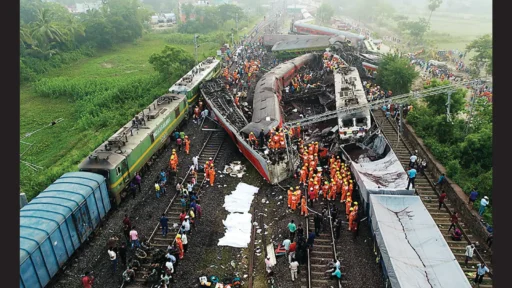
Introduction: A Catastrophe That Shocked the Nation
On the evening of June 2, 2023, a catastrophic triple‑train collision occurred in Balasore district, Odisha, near Bahanaga Bazar station. The incident involved the high-speed Coromandel Express, a stationary freight train laden with iron ore, and another passenger train, the SMVT Bengaluru–Howrah Superfast Express advancing on the adjacent track. In less than a minute, more than 21 coaches derailed. The final toll: 296 lives lost and over 1,200 injured. It instantly became India’s worst rail disaster in decades.
That Night: How It Happened
At around 19:00 IST, the Coromandel Express was mistakenly routed onto a loop line rather than the main track, resulting in a head‑on collision with the freight train at high speed. Momentum threw derailed coaches into the path of the Bengaluru–Howrah Express traveling in the opposite direction, causing further devastation. The force of the impact snapped metal, crushed compartments, and turned coaches into wreckage.
Immediate Aftermath & Rescue Efforts
The response was swift. Multiple agencies—including the National Disaster Response Force (NDRF), Odisha Disaster Rapid Action Force (ODRAF), local police, fire services, and volunteers—worked through the night to extract survivors. Hospitals in Odisha, West Bengal, and Tamil Nadu mobilized teams and ambulances to support relief efforts. Over 150 trains were delayed or canceled.
Root Causes & Public Outrage
Rail authorities attributed the crash to a signal failure in the electronic interlocking system. Investigators suspected that the Coromandel Express received incorrect routing instructions. The incident prompted a CBI-led investigation, and several railway officials were arrested for negligence.
Critics quickly pointed to wider systemic flaws: pending infrastructure upgrades, insufficient adoption of the anti-collision system Kavach, and chronic staff shortages flagged by Comptroller & Auditor General reports.
Impact and Political Fallout
Opposition parties demanded resignation of the Railway Minister, calling the tragedy “preventable” and an emblem of government mismanagement. Social media users demanded accountability and rapid modernization.
Prime Minister Narendra Modi expressed condolences and announced relief measures. Still, the opposition criticized the government for ignoring earlier warnings about rail safety and delayed implementation of safety upgrades.
Broader Safety Concerns: A Pattern and Not an Outlier
The Odisha collision was one among several tragic train incidents in 2023—including a train fire in Madurai (August) and a collision in Andhra Pradesh (October). Together, these incidents claimed over 300 lives in three major mishaps. Critics argue the death toll rose suddenly after a period of relative calm, raising urgent questions about railway management and policy priorities.
Lessons and Reforms Needed
This disaster highlighted glaring needs:
-
Full installation of anti-collision systems like Kavach across major routes
-
Upgrading outdated signal systems and interlocking infrastructure
-
Improved staffing, training, and maintenance procedures
-
Transparent and timely investigations when failures occur
-
Ensuring infrastructure modernization matches network expansion
India carries the world’s fourth-largest railway system. Despite modernization budgets exceeding $30 billion, critics say safety implementation lags behind scale.
Final Thoughts: A Wake-Up Call for Railway Safety
The Odisha disaster was not just another tragic headline—it was a national emergency spotlighting systemic neglect. With nearly 300 lives lost, the event underscores why safety reforms cannot be postponed.
For millions relying on rail travel daily, this incident must mark a turning point: where infrastructure modernization serves the purpose of preventative safety, not just expansion.